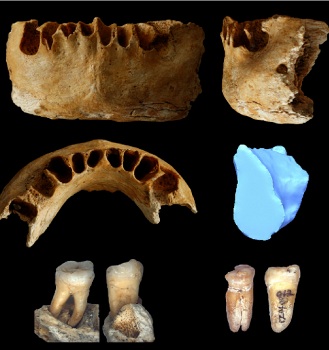We're open daily! View holiday hours
Science News
Human Fossil Discovery
November 3, 2010

By Anne Holden
Exciting announcements about human evolution have captured our attention recently. First, we added a new branch to our family tree with Ardipithecus ramidus, or “Ardi.” Then we learned our earliest primate ancestors may have evolved not in Africa (contrary to conventional wisdom) but in Asia. And now, fossil remains from China seem to radically change what we thought we knew about our species’ arrival in East Asia. It’s been a busy year for human evolution, and the year’s not over yet.
In the most recent discovery, published last week in the Proceedings of the National Academy of Sciences, an international team of experts described three fossils: two teeth and part of a jaw. The remains were found in Zhiren Cave in southern China. They date back 100,000 years, and the authors say the fossils are of human origin.
This discovery has ruffled a few feathers among the experts. Why? Because conventional wisdom places the arrival of humans into East Asia just 50,000 years ago. The remains from Zhiren Cave are twice as old.
Both fossil and genetic evidence place the origin of humans in Africa about 150,000 years ago. According to conventional widsom, humans didn’t make the long trek to Asia for another 100,000 years. Once they got there, most experts agree, they pushed out or replaced the groups of earlier ancestors, like Homo erectus, who had been living there for over a million years.
The discovery of these fossils may change that timeline. Erik Trinkaus from Washington University in St. Louis (and one of the paper’s authors) noted, “These fossils are helping to redefine our perceptions of modern human emergence in eastern Eurasia, and across the Old World.”
What makes these fossils so interesting isn’t just their age, the authors say. It’s the fact that they have a mix of human and archaic (you might say “pre-human”) features. The chin especially is decidedly human (our earlier ancestors were chin-impaired), while other features seem much more primitive. Are these remains the result of humans and Homo erectus “intermingling”?
This discovery does not come without its critics, however. John Hawks from the University of Wisconsin questions whether the presence of a chin alongside archaic features is a convincing enough argument. With so few remains, he says, we need to know how genes build the jaw in the first place before we can understand how these remains fit into the twigs and branches of our family tree.
Anne Holden, a docent at the California Academy of Sciences, is a PhD trained genetic anthropologist and science writer living in San Francisco.